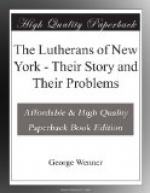RESOLVED, 2d, That on account of an intimate connection subsisting between the English Episcopal Church and the Lutheran Church and the identity of their doctrine and near alliance of their Church discipline, this Consistory will never acknowledge a new erected Lutheran Church merely English, in places where the members may partake of the Services of the said Episcopal Church.”
From the viewpoint of the ministers in 1797, Lutheranism seems to have been a matter of language rather than of religion. It was something to be retained among German-speaking people, but could not be effectively transmitted except through the medium of the German language.
We have come to the last decade of the 18th century. In the political world great men were finding themselves and mighty principles were finding expression in the organization of what was destined to become one of the great states of the world. Some of our own men were taking a large part in the making of American history. In the church they were content with a more restricted outlook. Our people, it is true, were of humble origin, yet some of them had attained wealth and social standing. The Van Buskirks, the Grims, the Beekmans, the Wilmerdings and the Lorillards were men of affairs and influence in the growing town of 30,000 that had begun to extend northward as far as Canal Street and even beyond. But we look in vain for any positive contribution to the life of the embryo metropolis of the world.
Our church had lost its roots. The Rhinebeck Resolution indicates the feeble appreciation of the distinctive confession to which she owed her existence. The English hymn books and liturgies of this period are equally destitute of any positive confessional character.
But after all, the church in New York only reflected in a small way the conditions that existed on the other side of the Atlantic. In the Fatherland the national life had been declining ever since the Thirty Years’ War. In 1806 Germany reached the nadir of her political life at the battle of Jena. In the church this was the period of her Babylonian Captivity. Alien currents of philosophical and theological thought had devitalized the teaching of the Gospel. The old hymns had been replaced by pious reflections on subjects of religion and morality. The Lutheran Liturgy had disappeared leaf by leaf until little but the cover remained. With such conditions in the homeland what could be expected of an isolated church on Manhattan Island? Take it all in all, it is not surprising that only two congregations survived. It is a wonder that there were two.
In “Old New York” Dr. Francis presents a vivid picture of the social and religious life of this period and from it we learn that the Lutherans were not the only ones whose religion sat rather lightly upon them. French infidelity had taken deep root in the community and Paine’s Age of Reason found enthusiastic admirers.




